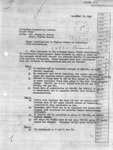Exactly. There were sistems, as you mentioned, late in the war, to switch frequency remotely, only for short range (VHF), but even that did not mean that radios coud be placed everywhere in the aircraft.
For HF it was more difficult as, changing frequency, say from 15 Mhz (vawelenght 20 m) to 30 Mhz (vawelenght 10 m), required theoretically different lenghts of the antenna, so transmitter and antenna system had to be closely matched, otherways a too high SWR
Standing wave ratio - Wikipedia .... (for simplicity...)
could cause serious problems, and even destroy the final stage of the transmitter.
Zerstörers had at the beginning of the war a crew of three for reasons.
To change frequency was absolutely fundamental, see the bottom of the blackboard:

For HF it was more difficult as, changing frequency, say from 15 Mhz (vawelenght 20 m) to 30 Mhz (vawelenght 10 m), required theoretically different lenghts of the antenna, so transmitter and antenna system had to be closely matched, otherways a too high SWR
Standing wave ratio - Wikipedia .... (for simplicity...)
could cause serious problems, and even destroy the final stage of the transmitter.
Zerstörers had at the beginning of the war a crew of three for reasons.
To change frequency was absolutely fundamental, see the bottom of the blackboard:
Last edited:

